Gustav Klimt The Biography
Gustav Klimt (1862–1918) and his contemporaries had a seminal influence on the art world of the fin de siècle. His most important milestones on the way to the “Gesamtkunstwerk” or universal work of art are outlined in more detail under the following biographical stages.
1862–1875
 1
1
 2
2
 3
3
Gustav Klimt was born on 14 July 1862, the second of seven children of Ernest (1834–1892) and Anna Klimt (1836–1915, née Finster) at No. 247 Linzer Straße in Baumgarten near Vienna.
While Gustav Klimt attended elementary and secondary school at No. 61 Lerchenfelder Straße, his family relocated several times. In 1867 they moved from the suburbs to No. 50 Lerchenfelder Straße, into a house named “The Golden Lion” (“Haus zum goldenen Löwen” in Vienna’s Eighth District, Josefstadt). Shortly thereafter, they lived at No. 51 Neubaugasse, in a house called “The Blue Bottle” (“Haus zur blauen Flasche” in Vienna’s Seventh District, Neubau). In 1874, they removed to No. 48 Märzstraße and, after one year, again to No. 40 Märzstraße (Vienna’s Fifteenth District, Rudolfsheim-Fünfhaus).
1876–1878/79
 1
1
 2
2
 3
3
In October 1876, Gustav and Ernst (1864–1892) Klimt, wishing to become drawing teachers, took the entrance examination to the School of Arts and Crafts affiliated with the Imperial-Royal Austrian Museum of Art and Industry (No. 3 Stubenring in Vienna’s First District, Inner City; now University of Applied Arts Vienna). Having both passed their exams, they attended different preparatory schools until 1878, learning the basics skills of drawing and painting mostly by copying plaster statues and taking life classes. During this time, the brothers met their fellow student Franz Matsch (1861–1942). Klimt’s younger brother Georg (1867–1931) also was to take up his studies at this school.
In 1878/79, Gustav Klimt and Franz Matsch were admitted to the “School for Drawing and Painting,” which was headed by the school’s director, Ferdinand Laufberger (1829–1881). Ernst would follow in the subsequent year. They received a scholarship of 20 florins per month.
In 1877, the Klimt family relocated to No. 8 Neubaugasse (Vienna’s Seventh District, Neubau). Only one year later they had to move again, finding a new domicile on the third floor of No. 75 Mariahilfer Straße (Vienna’s Sixth District, Mariahilf; apartment no. 37).
1877 was also the year when the Historicist Villa Paulick in Seewalchen on the Attersee was completed. This jewel of a villa, commissioned by Friedrich Georg Paulick (1824–1904) and built by the architects Friedrich König (1842–1906) and Rudolf Feldscharek (1845–1919), would become an important meeting place for numerous artists, including Gustav Klimt, who visited from 1900 onward.
1880–1882
 1
1
 2
2
 3
3
The young painters were offered to share a studio at the School of Arts and Crafts. It was the birth of the collective known today as “Künstler-Compagnie.” In 1880, while still training as decorative painters, they received one of their first commissions, designing four ceiling paintings for the parlor of the Sturany Palace in the Inner City (Vienna’s First District). Shortly thereafter they were entrusted with the ceiling paintings for the spa building of Karlsbad (now Karlovy Vary).
Laufberger died in 1881, and his class was taken over by Julius Victor Berger (1850–1902). He, too, allowed the young trio of painters to assist him in his projects, such as in the decoration of the Zierer Palace (no Palais Kranz, Vienna’s Fourth District, Wieden). In 1882 followed the commission for the decoration of the Brno Municipal Theater. That year, they also began tackling their first major independent commission for the Municipal Theater of Reichenberg (now F. X. Šalda Theater, Liberec).
Starting in 1881, in addition to his large-scale decoration projects, Klimt also contributed to Martin Gerlach’s compilation of original designs Allegorien und Embleme. Abtheilung Allegorien [“Allegories and Emblems”], to the part devoted to allegories.
1883–1885
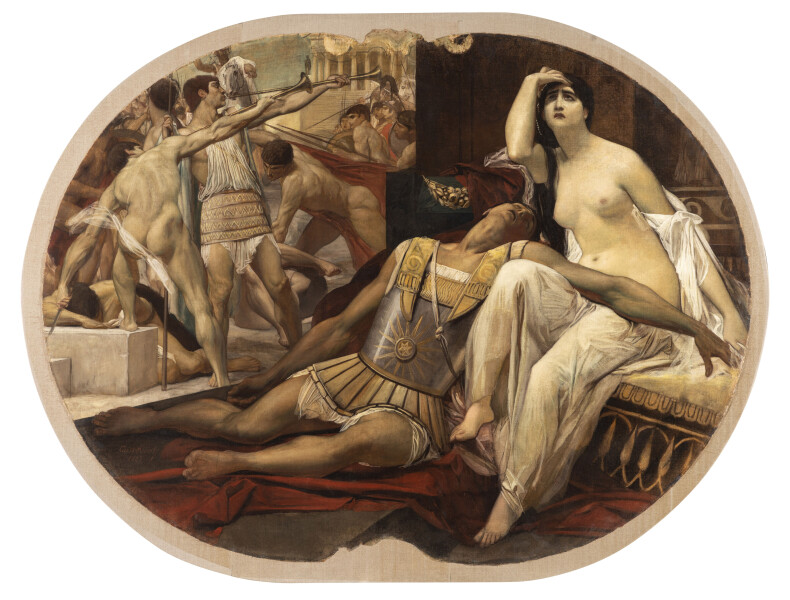 2
2
 3
3
The “Künstler-Compagnie” strengthened its position as a group of decorative painters and from 1883 worked on a large-scale commission for Peleș Castle in Romania. The collective moved into a new shared studio at No. 8 Sandwirtgasse (Vienna’s Sixth District, Mariahilf).
It was presumably in 1884 that the Klimt brothers and Franz Matsch were entrusted with the decoration of the Fiume Municipal Theater (now Rijeka). In addition, the “Künstler-Compagnie” was commissioned to decorate the Municipal Theater of Karlsbad (now Karlovy Vary). A year later, they were called in to decorate the Hermesvilla in Lainz near Vienna.
In 1884, the Klimt family moved once again and found new quarters at No. 6 Stuckgasse (Vienna’s Seventh District, Neubau; apartment no. 2).
1886–1889
 1
1
 2
2
1886 and the subsequent two years were marked by the impressive decoration project of the grand staircases of Vienna’s Imperial-Royal Court Theater (now Burgtheater).
In 1888, Gustav Klimt was honored with the Golden Cross of Merit. He met August (1857–1936) and Serena (Szerena, Sidonie) Lederer (née Pulitzer, 1867–1943), who would become his principal patrons. In his gouache Auditorium of the Old Burgtheater, Klimt has immortalized Serena’s face amidst more than 130 illustrious figures of Viennese society.
Klimt traveled to Innsbruck, Salzburg, and the Königssee, to Krakow, Trieste, and Munich. In August 1889 he sojourned in the Upper Austrian Salzkammergut, in St. Wolfgang and Gmunden.
1890
 1
1
 2
2
Klimt’s Auditorium of the Old Burgtheater was presented as part of the “XIX. Jahresausstellung des Künstlerhauses” [“19th Annual Exhibition of the Künstlerhaus”]. The artist was awarded the Emperor’s Prize for this work. In addition, the collective of painters around Gustav Klimt was asked to decorate the grand staircase of the Imperial-Royal Museum of Art History (now Kunsthistorisches Museum, Vienna).
Having had to move again, the Klimt family now lived at No. 47 Burggasse (Vienna’s Seventh District, Neubau). The “Künstler-Compagnie” also relocated their studio to No. 21 Josefstädter Straße (Vienna’s Eighth District, Josefstadt). That year, Klimt is known to have traveled to Italy for the first time, a journey he undertook in the company of his brother Ernst and which took them to Trieste and Venice [or “Wehnedig,” Klimt’s spelling for the German name “Venedig”] via Villach.
That year, the families Klimt and Flöge met for the first time.
1891–1893
 1
1
 2
2
In March, Gustav Klimt was admitted to the Cooperative of Visual Artists in Vienna (now Künstlerhaus, Gesellschaft bildender Künstlerinnen und Künstler Österreichs) as a member.
His brother Ernst married Helene Flöge (1871–1936). This event cemented Gustav’s relationship with the bride’s sister, fashion designer Emilie Flöge (1874–1952). After only a year, Klimt’s father Ernest died in July, followed by Ernst in December. Klimt became the guardian of his niece, Helene “Lentschi” Klimt (1892–1980), taking the matters of the half-orphan into his hands with fatherly care.
These misfortunes within the family plunged Klimt into an artistic crisis, which eventually led to his reorientation. The “Künstler-Compagnie” began to lose ground; Gustav Klimt and Matsch nevertheless continued to share the Josefstadt studio until 1894. The enchanted backyard studio would offer Klimt an ideal retreat and place of inspiration until 1911.
In 1892, Klimt undertook a journey to Totis (now Tata) in Hungary, as Count Esterházy wished to have a picture painted of the theater auditorium of his castle. In 1893 the finished work was shown at the “XXII. Jahresausstellung des Künstlerhauses” [“22nd Annual Exhibition of the Künstlerhaus”], and Klimt received a Silver State Medal for it. He was also entrusted with the decoration of the music room at the Dumba Palace (Vienna’s First District, Inner City) in the form of the two overdoors Music and Schubert at the Piano. The project was only realized after about four years.
1894
 1
1
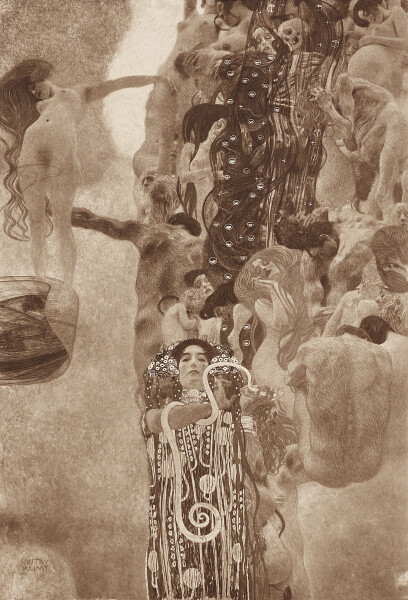 2
2
 3
3
In September 1894, Gustav Klimt and Franz Matsch were commissioned to paint the Faculty Paintings for the ceiling of the Great Hall of the Imperial-Royal University of Vienna. Klimt designed the allegorical representations of Philosophy, Medicine, and Jurisprudence. Matsch tackled the theme of Theology and designed the large central panel. Klimt would not complete his paintings before 1907; it was to be his last public commission and caused a great stir.
Klimt won another prize for his work Auditorium of the Theater of Esterházy Palace in Totis at the Antwerp World’s Fair, where he was awarded a certificate of honor.
Klimt’s application for a professorship at the Academy of Fine Arts’ School of History Painting was declined.
1895–1896
 1
1
 2
2
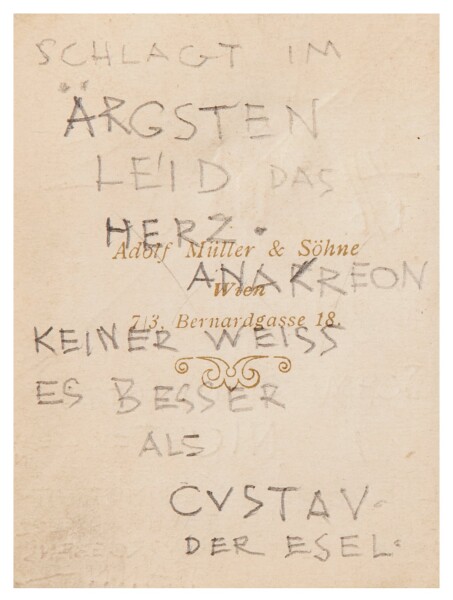 3
3
The relationship between the artist and Emilie Flöge became more and more intense. On 16 February 1895, he entered his name in Flöge’s dance card for the “Trachtenkränzchen,” a traditional costume ball organized by the Vorarlberg Society in Vienna, adding freely quoted lines by the Greek poet Anacreon. In the summer, the two of them, seeking recreation, spent time together in Langenwang in Styria.
Klimt received another commission from Martin Gerlach and from 1895 designed four allegorical representations for the compilation of original designs Allegorien. Neue Folge [“Allegories. New Series”]. In 1896 his designs were exhibited at the Vienna Künstlerhaus. It was in this context that Kolo Moser (1868–1918) met his future companion Gustav Klimt. That year, Klimt was elected to the board of trustees of the Society for Reproductive Art.
1897
 1
1
 2
2
 3
3
 4
4
Discrepancies within the Cooperative of Visual Artists in Vienna became increasingly obvious. A new understanding of art proclaimed by many artists around Gustav Klimt led to the foundation of the avant-gardist Union of Austrian Artists Secession. This went hand in hand with their departure from the Vienna Künstlerhaus, which was meanwhile perceived as too conservative and traditional. Not only was Klimt elected president of the new association, he also participated actively in designing the Secession’s future building.
Klimt and his mother and brothers and sisters moved to a new apartment on the second floor at No. 36 Westbahnstraße (Vienna’s Seventh District, Neubau; apartment no. 12), where he would live until his death. He undertook a trip to Munich and spent the summer with Emilie and her sisters in Fieberbrunn in Tyrol. Klimt began his correspondence with Maria “Mizzi” Zimmermann (1879–1975), his model and mother of two of his future children.
1898
 1
1
 2
2
 3
3
The first exhibition of the Vienna Secession took place in the flower halls of the Imperial-Royal Horticultural Society on Parkring (Vienna’s First District, Inner City). Klimt designed the poster for the show, which could only be placarded in its censored version. The cover of the May/June issue of Ver Sacrum likewise showed this motif by Klimt. Emperor Francis Joseph I (1830–1917) visited the show and was given a tour of the premises by Klimt and Carl Moll (1861–1945). The Vienna Secession’s second exhibition opened in November, in the new Secession building designed by Joseph Maria Olbrich (1867–1908) near the Naschmarkt (Vienna’s First District, Inner City).
Klimt became a corresponding member of the Munich Secession.
At this time, Klimt developed an expressive “Secessionist” style, combining flatness, frontality, and golden luster with a Post-Impressionist brushwork. The Ministry of Education’s art commission criticized Klimt’s Faculty Paintings, and he was asked to revise them. Klimt rented a second studio with higher-ceilinged rooms at No. 54 Florianigasse (from 1906: house no. 50), which he would use until 1907 in addition to the studio at No. 21 Josefstädter Straße.
He spent the summer in St. Agatha in the Salzkammergut with the Flöge family, painting his first large-sized landscapes in portrait format. Having also becoming a portraitist of Viennese society, Klimt immortalized Sonja Knips (1873–1938) in oil on canvas. This was his first portrait in square format. Around the same time, he also captured the young Maria Ucicka (1880–1928), a model and mother of his first son, in the small-sized, intimate portrait Girl in the Foliage.
1899
 1
1
 2
2
 3
3
This year, Klimt participated not only in the Vienna Secession’s exhibitions, but also premiered at the Venice Biennale, combining his engagement there with an extensive tour in the company of the Moll family and other important friends. A blossoming liaison between Klimt and Alma Schindler (1879–1964), Moll’s stepdaughter, was discovered during this trip and put a stop to.
Klimt’s earliest known letter to Maria Ucicka was sent on 12 June. Their son Gustav Ucicky (d. 1961) was born in July. Only a few months later, in September, Gustav Zimmermann (d. 1976), the son of Maria “Mizzi” Zimmermann and Klimt, was born.
Klimt spent the summer with the Flöge family in Golling near Hallein in Salzburg. From then on, his landscape paintings would be characterized by their square format. Klimt painted Serena Lederer’s portrait.
Important companions of Klimt, Josef Hoffmann (1870–1956) and Kolo Moser took up their teaching posts at the School of Arts and Crafts that year.
1900
 1
1
 2
2
 3
3
At the Vienna Secession’s 7th exhibition, Klimt presented landscape paintings dating from recent years, as well as the Faculty Painting of Philosophy. The progressive composition provoked a scandal and outrage. The work was withdrawn, but shortly thereafter presented at the Paris World’s Fair, where the artist won the grand prize for his painting.
That year, Klimt spent his first summer vacation at the Attersee in Upper Austria in the company of the Flöge family. Further stays were to follow, with the Bräuhof in Litzlberg remaining his preferred accommodation until 1907. From 1900 on, the Villa Paulick – Klimt signed the guest book for the first time on 10 August – would be an inspiring and habitual meeting place during their stays at the lake. He completed several paintings even during this first stay of his, as Klimt mentioned in a letter to Zimmermann. A multitude of photographic snapshots by Emma Bacher (née Paulick, 1867–1953), Heinrich Böhler (1881–1940), Friedrich Gerhard Walker (1873–1934), and others vividly document the Attersee summer retreats of Gustav Klimt and his companions, their refuge of seventeen years.
1901
 1
1
 2
2
At the Vienna Secession’s 10th exhibition, Klimt presented Medicine, another Faculty Painting, in a room designed by Kolo Moser, next to landscapes and portraits painted at the Attersee. Once again, Klimt earned criticism for the picture. This was followed by another exhibition in Vienna, and he also participated in shows in Dresden and Munich. In the Bavarian capital, the Faculty Painting aroused a keen interest. What is more, the Bavarian government purchased Klimt’s Music (Study) for the Neue Pinakothek. Klimt painted Judith I.
As usual, Klimt spent the summer at the Attersee. Inspired by the picturesque surroundings of the village of Litzlberg, he painted several mystical forest views, such as Pine Forest I. The cropped view and painting style reveal borrowings from photography. The picture is reminiscent of the photograph Forest Interior, which Moriz Nähr (1859–1945), Klimt’s favorite photographer, had taken about ten years earlier. During his summer retreat, Klimt worked on the transfer sketches for his monumental work The Beethoven Frieze, which was to be presented at the Vienna Secession the coming year.
1902
 1
1
 2
2
The thirty-four-meter-long Beethoven Frieze was presented on the occasion of the Vienna Secession’s 14th exhibition, the so-called “Beethoven Exhibition.” Klimt began painting the iconic portrait of Emilie Flöge, his soulmate.
Otto, the second son of Klimt and Maria “Mizzi” Zimmermann, was born, but died that same year. In a letter to the child’s mother from the beginning of August, Klimt outlined the function of his “motif finder,” an optical aid he used, among other things, to define the perspective of his pictures. In another letter of 17 August he described his daily summer routine and the landscape paintings currently in progress.
1903
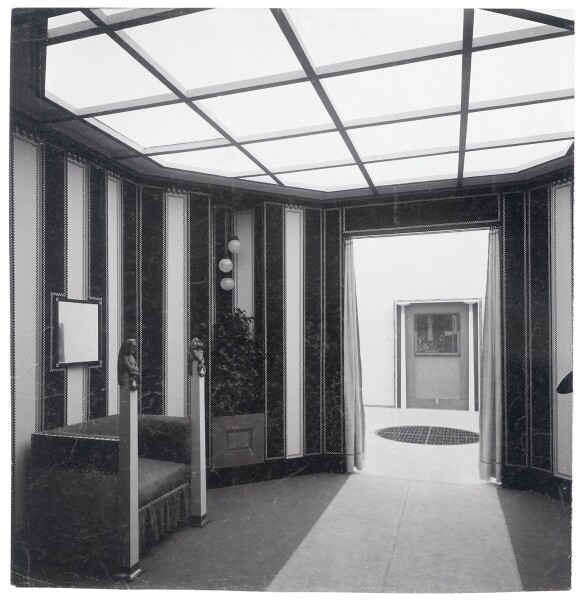 1
1
 2
2
 3
3
Klimt participated in several exhibitions. At the Vienna Secession’s 18th exhibition, the so-called “Kollektiv-Ausstellung Gustav Klimt” [“Gustav Klimt Collective Exhibition”], he presented more than eighty works. All three of the Faculty Paintings were shown together for the first time in their current, not yet completed states. Hope I was also on view. However, Minister of Education Wilhelm Ritter von Hartel (1839–1908) intervened due to the showcased nudity of a pregnant woman, which led to the withdrawal of said painting. Due to the resulting rehanging, the opening had to be postponed for four days.
Ferdinand Bloch-Bauer (1864–1945) commissioned Klimt to paint the first portrait of his wife, Adele (1881–1925, née Bauer).
Klimt traveled to Italy twice that year, where he studied the fascinating mosaics of Ravenna and Venice, which had a major influence on his work. He concluded his winter vacation with a stay at Lake Garda.
Fritz Waerndorfer (1868–1939), Josef Hoffmann, and Kolo Moser founded the Wiener Werkstätte, an innovative production cooperative that would have a main share in the dissemination of a typically Viennese variant of Art Nouveau in all genres of art.
1904
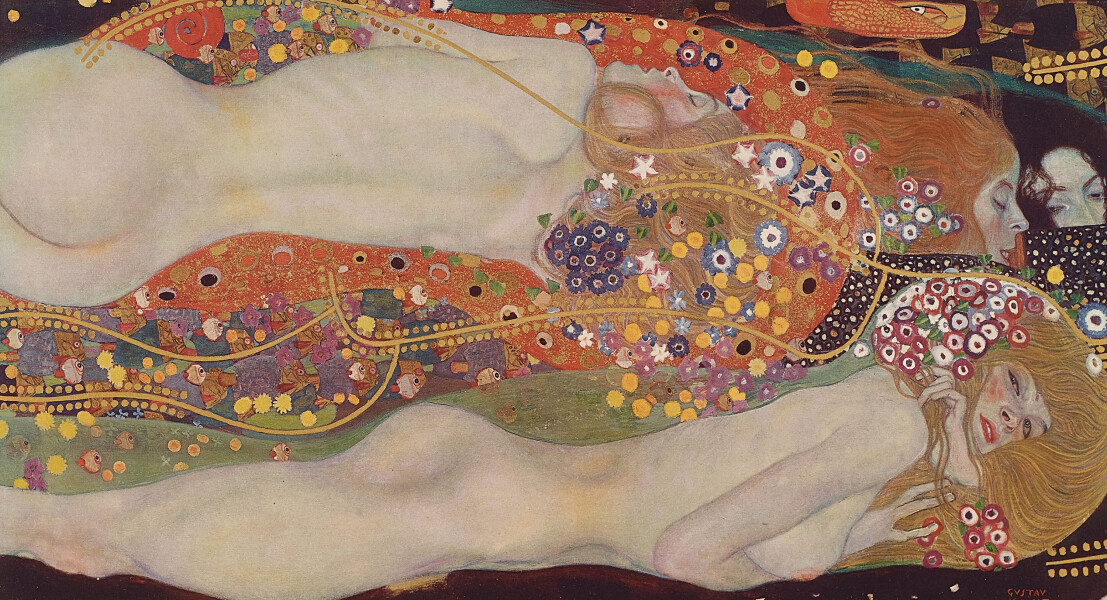 1
1
Plans for the Stoclet Palace in Brussels, the quintessence of a Gesamtkunstwerk or universal work of art, became more and more concrete. Involved in the project alongside the Wiener Werkstätte, Klimt received the commission to design the famous Stoclet Frieze. He participated in the Vienna Secession’s 20th exhibition, presenting Water Snakes II for the first time. He also took part in the “Große Kunstausstellung Dresden” [“Great Dresden Art Exhibition”] and the “X. Ausstellung der Münchner Secession” [“10th Exhibition of the Munich Secession”]. The Vienna Secession’s show intended to focus on Klimt’s paintings, which had been planned by Hoffmann for the “St. Louis World’s Fair” in the United States, was not realized.
Together with her sisters, Emilie Flöge opened the exclusive “Schwestern Flöge” fashion salon at the Casa Piccola at No. 1b Mariahilfer Straße. The interiors, standing out for their plain appearance and geometric patterns, had been designed by Hoffmann and Moser and realized with the support of the Wiener Werkstätte. Klimt contributed the design for the signet. Viennese ladies of distinction, such as Sonja Knips, Hermine Gallia (1870–1936, née Hamburger), and members of the Lederer family, took to having their dresses made by Emilie Flöge. The fashion designer propagated a modern style inspired by the idea of the dress reform.
Paul Bacher (1866–1907) bought Galerie H. O. Miethke, which had been founded by Hugo Othmar Miethke (1834–1918) in the early 1860s and developed into one of the foremost art dealers of the fin de siècle. From that year, the gallery also acted as the principal dealership of Klimt’s works.
Hoffmann decorated Klimt’s studio at No. 21 Josefstädter Straße with furniture from the Wiener Werkstätte. Klimt was not very enthusiastic about this project.
1905
 1
1
 2
2
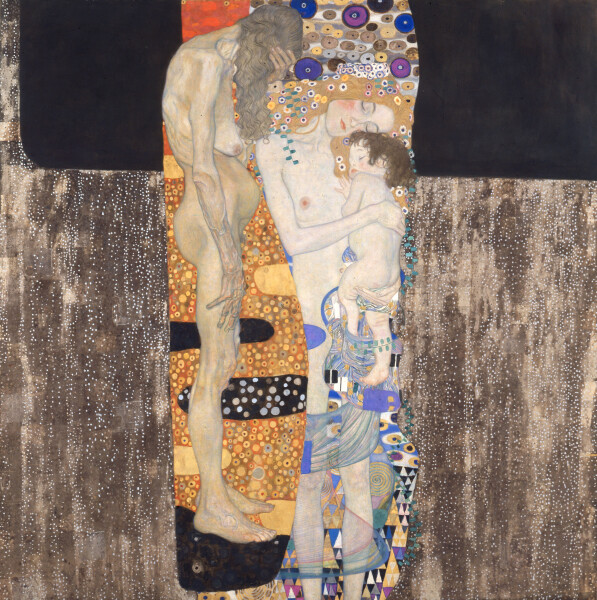 3
3
Klimt officially withdrew from the project of the Faculty Paintings and returned the advance payment he had received.
The Klimt Group, including, among others, Josef Maria Auchentaller (1865–1949), Josef Hoffmann, Maximilian Kurzweil (1867–1916), Richard Luksch (1872–1936), Carl Moll, Emil Orlik (1870–1932), Otto Wagner (1841–1918) and, of course, Klimt himself, resigned from the Vienna Secession after disagreements and ever-increasing discrepancies among the members.
Friedrich Viktor Spitzer (1854–1922) took a series of portrait photographs featuring Gustav Klimt. The painter visited the Purkersdorf Sanatorium and painted his hitherto largest easel painting, The Three Ages of Woman.
1906
 1
1
 2
2
Klimt was appointed honorary member of the Royal Bavarian Academy of Fine Arts in Munich.
In May he undertook a trip to London and on the way back inspected the construction site of the Stoclet Palace in Brussels. He returned to Vienna via Berlin and Dresden. From what is known from a picture postcard to his sister Johanna “Fanny” Klimt, he also stayed in Florence that year, probably to visit the Villa Romana, which was administered by the Union of German Artists – an early form of an “artist residency.”
During his obligatory summer retreat at the Attersee, Klimt photographed a twenty-part fashion series with Emilie Flöge wearing her own creations. In the fall, ten photographs were published in the art magazine Deutsche Kunst und Dekoration under Klimt’s authorship.
1907
 1
1
 2
2
 3
3
The now-completed Faculty Paintings were first presented at Galerie H. O. Miethke, followed by Kunstsalon Keller & Reiner in Berlin. Klimt’s depictions of the faculties and his painting style were regarded as groundbreaking in Germany.
The German version of Lucian’s Dialogues of the Courtesans by Franz Blei (1871–1942) was illustrated by Klimt with fifteen erotic drawings. Klimt completed one of his major works of the Golden Period: Portrait of Adele Bloch-Bauer I. That same year, the picture was presented together with other works at the “Jubiläums-Ausstellung Mannheim” [“Mannheim Jubilee Exhibition”].
Klimt and Egon Schiele (1890–1918) met for the first time, which resulted in an important and inspiring connection, especially for the younger artist.
Klimt attended the opening of the Kabarett Fledermaus, which had been designed and decorated by the Wiener Werkstätte. Further visits would follow. His painting Friends I (The Sisters), which he completed that year at the Attersee, exhibits a color scheme similar to that of the famous nightclub and probably depicts two of the famous Wiesenthal sisters.
1908
 1
1
 2
2
 3
3
The Klimt Group organized the groundbreaking and impressive “Kunstschau Wien” on the site of the future Konzerthaus in Vienna’s Third District (Landstraße). Hoffmann was in charge of the overall architectural concept. Klimt exhibited sixteen paintings and eighteen drawings in altogether three rooms. Kolo Moser was responsible for the decoration of the main room. The painting The Kiss, presented under its subtitle Lovers, was purchased by the Imperial-Royal Ministry of Culture and Education for the Modern Gallery. It was handed over after its completion the following year. Moreover, the Lower Austrian Provincial Committee purchased Klimt’s Portrait of Emilie Flöge. The first “Kunstschau” also proved trailblazing and career boosting for the generation of younger artists. For example, one of those represented at the “Kunstschau” was Oskar Kokoschka (1886–1980), who would soon step out from under the shadow of the Wiener Werkstätte.
In order to market Klimt’s great artistic achievements also beyond Austria’s borders, the H. O. Miethke publishing house edited a high-quality portfolio of Klimt’s works created until 1914. The artist himself selected the works meant to illustrate the volume and oversaw the reproduction process.
The photographer Madame d’Ora (Dora Kallmus, 1881–1963) shot an impressive series of portraits of Klimt.
During one of his visits to the Kabarett Fledermaus, Klimt witnessed the dance debut of the Wiesenthal sisters at this venue, whom he already knew and whom he had presumably portrayed the previous year.
From this year onward, Klimt and the Flöge family stayed at Villa Oleander when spending their vacation at the Attersee. This rentable accommodation was part of the extensive complex of the Hôtel Seehof in Kammerl, a district of Kammer-Schörfling. Pictures of Emilie Flöge in a bat-like dress and Klimt in his painter’s smocks document these stays photographically. The artist had also taken an interest in Kammer Castle and the surrounding park, completing a series of seven paintings by 1912. In addition, Klimt was forced to devote almost his entire “Kammerl time” to his designs for the Brussels Stoclet Frieze, a project that proved most laborious and considerably overshadowed the joys of summer.
1909
 1
1
The Klimt Group organized the “Internationale Kunstschau,” with Schiele participating thanks to Klimt’s support. The show also presented such international positions as those of Vincent van Gogh (1853–1890), Paul Gauguin (1848–1903), Edvard Munch (1863–1944), and Max Liebermann (1847–1935).
Klimt undertook a trip to France together with Moll, which they combined with a stay of several days in Central Spain. It was above all the art of El Greco (1541–1614) that left a lasting impression on the Jugendstil painter.
1910
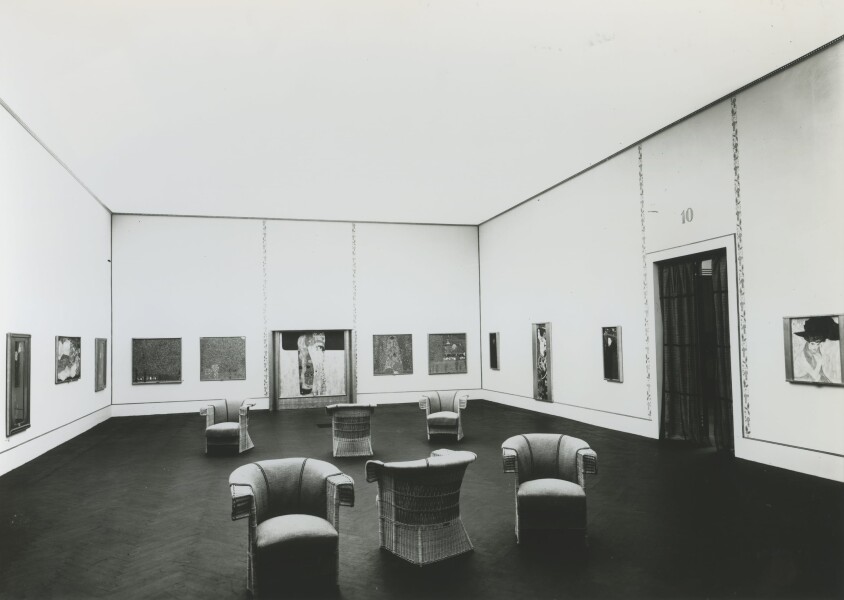 1
1
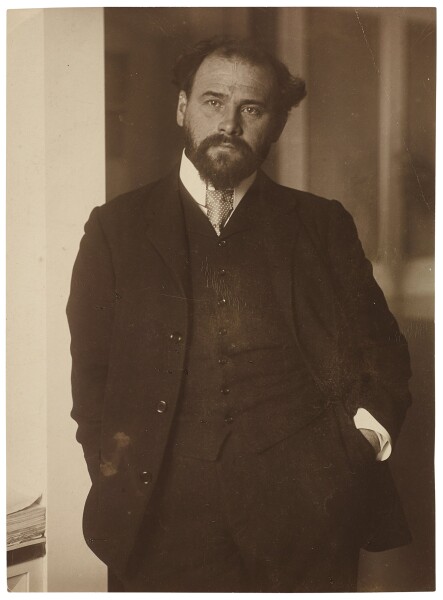 2
2
 3
3
Klimt took part in a number of exhibitions, including the Venice Biennale, where he appeared for the second time. He was given his own showroom, where he presented twenty-two paintings. In the course of this show, the Municipal Gallery of Venice bought the painting Judith II (Salome). Klimt was also represented in an exhibition in Prague and attended the performance of Gustav Mahler’s Symphony No. 8 in Munich in the company of Alma Mahler (née Schindler), Kolo Moser and his wife, Alfred Roller (1864–1935), and Adele Bloch-Bauer.
The artist set to work on his monumental allegory Death and Life (Death and Love), which he reworked in 1912/13 and 1916/17.
1911
 1
1
 2
2
 3
3
 4
4
This year particularly saw the completion of the true-to-scale work drawings for the Stoclet Frieze in Brussels. In the summer, Leopold Forstner (1878–1936) set to work on the mosaic in his workshop in Vienna. The materials required for its realization were manufactured by various companies involved in the project. Toward the end of October, two of the Stoclet Frieze panels were presented to the Viennese public in Forstner’s mosaic workshop. Then the time-consuming and complicated transfer to Brussels began.
Klimt participated in the “International Art Exhibition of Rome” and was honored with a cash prize. Hoffmann had designed the Austria Pavilion.
Due to demolition work, the painter was forced to leave his backyard studio in Vienna’s Eighth District (Josefstadt). In May, Moriz Nähr still documented the situation in situ, taking the famous portrait photograph of Klimt with a cat in his arms. The painter temporarily moved into the barely used villa of Helene Hochstetter on Hohe Warte. After only a few months he was able to move into his last studio at No. 11 Feldmühlgasse (formerly No. 9, Vienna’s Thirteenth District, Hietzing), facilitated by Felix Albrecht Harta (1884–1967). Around the same time, the German-American photographer Pauline Hamilton (1870-1918, née Kruger) also captured Gustav Klimt in photographs.
1912
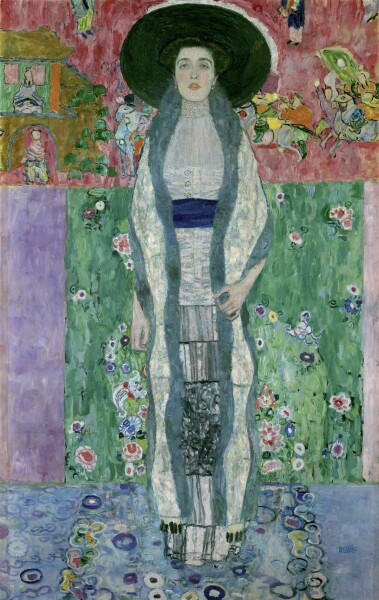 1
1
 2
2
 3
3
Klimt was elected president of the Austrian Artists’ League. He participated in the “Große Kunstausstellung Dresden” [“Great Dresden Art Exhibition”] and portrayed Adele Bloch-Bauer for the second time. Klimt completed his series devoted to Kammer Castle; inspired by the style of Vincent van Gogh, he painted Avenue in Front of Kammer Castle on the Attersee.
Schiele moved into a studio at No. 101 Hietzinger Hauptstraße, in the immediate vicinity of Klimt’s studio. Gustav, the first child of Klimt and Consuela Camilla “Ella” Huber (1896–1978), was born.
Klimt traveled to Bad Gastein with Emilie Flöge for the first time to take a cure. Further stays would follow.
1913
 1
1
 2
2
 3
3
Klimt exhibited in Budapest, (probably) Chernivtsi, Mannheim, Leipzig, and Munich and participated in the “Internationale Schwarz-Weiß-Ausstellung” [“International Black-and-White Exhibition”] in Vienna with over ninety drawings. Klimt found important patrons in Otto (1868–1926) and Eugenia Primavesi (1874–1963, née Butschek), who also supported the Wiener Werkstätte. They commissioned a portrait of their daughter, which Klimt realized that same year. A portrait of the child’s mother would follow shortly afterwards.
The Japanese painter Kijiro Ohta (1883–1951) visited Klimt in his Feldmühlgasse studio in May to describe their encounter in a Japanese art magazine.
In spring, Klimt sojourned at the Attersee for a few days, while he spent this year’s summer at Lake Garda in Northern Italy, where the artist captured his impressions in three landscape paintings. The return journey took him to Vienna via Tyrol and a brief stopover at the Attersee. In Upper Austria, Friedrich Gerhard Walker took the only known color photographs of Gustav Klimt and Emilie Flöge using the so-called Autochrome Lumière process. Again, Klimt treated himself to a stay at the spa in Bad Gastein.
1914
 2
2
 3
3
Klimt contributed ten works to an exhibition of the Union of German Artists in Prague. In the course of the show, the Modern Gallery of Prague bought Klimt’s allegory The Virgin. Moreover, the artist took part in the “II. Internationale Kunstausstellung der Secession” [“2nd International Art Exhibition of the Secession”] in Rome. The rooms reserved for the Vienna Secession were designed by Dagobert Peche (1887–1924).
In May he visited the Stoclet Palace in Brussels, about which he raved in a picture postcard to Emilie Flöge. Only the imposing mosaic frieze in the dining room did not quite come up to his expectations.
Anton Josef “Antios” Trčka (1893–1940) photographed a series of portraits of Klimt and Schiele. Moriz Nähr captured Klimt on his way to the Tivoli amusement park. The time out there and convivial rounds with the members of the so-called “Skittles Club” and “Breakfast Society” offered Klimt some welcome diversion.
Again, he went to Bad Gastein to take a cure. For the first time, he spent his Atterse summer vacation at the forester’s house in Weißenbach, whereas the Flöge family stayed at Haus Donner in nearby Steinbach. Enjoying the peace and inspiring surroundings, he immortalized his domicile twice in his paintings. Emperor Francis Joseph I sojourned in nearby Bad Ischl, where he signed the declaration of war against Serbia.
Charlotte (d. 1915), the daughter of Klimt and Consuela Camilla “Ella” Huber, was born.
1915
 1
1
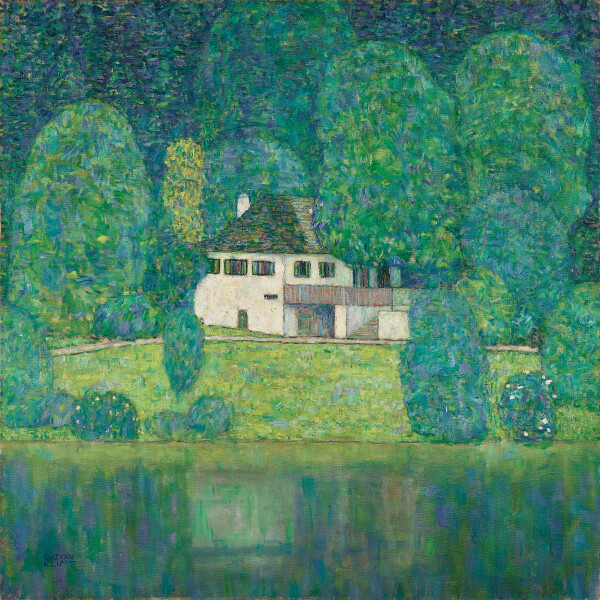 2
2
 3
3
Klimt participated in the “Kunstausstellung des Wirtschaftsverbandes bildender Künstlers Österreichs” [“Art Exhibition of the Trade Association of Austrian Visual Artists”]. The show was organized by several artists’ collectives and realized with the support of the Imperial-Royal Ministry of Culture and Education.
Arthur Schnitzler (1862–1931) and his wife visited Klimt in his Hietzing studio. The writer had received one of the master’s drawings for his birthday and came to have it signed. Wiener Werkstätte muse Friederike Maria Beer (1891–1980) also made an appearance at the artist’s studio to engage Klimt for a portrait commission. The contact had been established by the painter Hans Böhler (1884–1961). A year earlier, Beer had been portrayed by Schiele.
Klimt’s mother Anna died in February. Wilhelm (d. 1943), the second son of Consuela Camilla “Ella” Huber and Klimt, was born.
The painter continued to spend the summer months on the southern shore of the Attersee, revisiting his first summer resort in terms of motifs in the landscape paintings Litzlberg on the Attersee and Litzlberg Keller on the Attersee. He stayed with the Primavesi family at their country house built by Hoffmann in Winkelsdorf (now Kouty nad Desnou) for the first time.
1916
 1
1
 2
2
 3
3
The famous “Vienna Kunstschau” was held at the Berlin Secession, presenting a total of seventy works selected by the Austrian Artists’ League. Klimt, Schiele, and Kokoschka also figured in this exhibition. Schiele’s painting Transfiguration (The Blind II) was shown opposite Klimt’s allegory Death and Life (Death and Love).
Klimt became a member of the Saxon Academy of Fine Arts in Dresden.
Klimt undertook another trip to the Primavesi family in Winkelsdorf. In the summer, he stayed at the Attersee for the last time, painting, among other pictures, Garden Path with Chickens. This time, he had a visit from Friederike Maria Beer. Erwin Böhler (1877–1950), a cousin of Hans Böhler, bought the small island of Litzlberg.
Emperor Francis Joseph I died in Vienna on 21 November.
1917
 1
1
 2
2
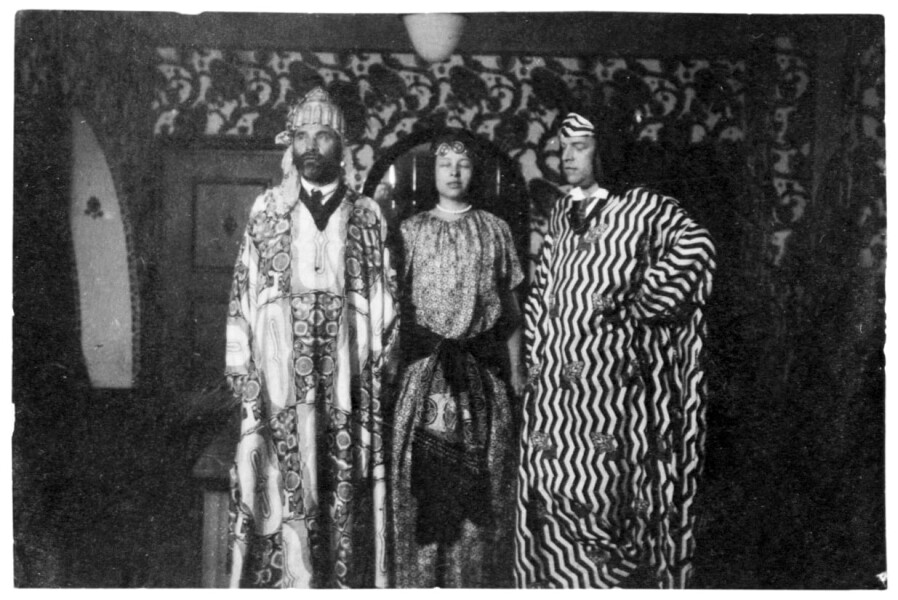 3
3
Klimt was appointed honorary member of the Academies of Fine Arts in Vienna and Munich and exhibited at the “Österrikiska Konstutställningen” [“Austrian Art Exhibition”] in Stockholm. Around the turn of the year, that show was also presented to the public in a reduced version in Copenhagen under the title of “Østrigsk Kunstudstilling. Maleri. Plastik. Kunstgenstande” [“Austrian Art Exhibition. Painting. Sculpture. Art Objects”].
Moriz Nähr documented Klimt’s studio and garden in Feldmühlgasse, thus recording the original structure for posterity.
The art publisher Hugo Heller (1870–1923) acquired the publishing rights and remaining copies of the portfolio Das Werk Gustav Klimts [The Work of Gustav Klimt], which had originally been published by Miethke and which would come out as a new edition the following year.
Klimt traveled to Bad Gastein again, devoting one of his pictures to the buildings cascading down the slopes.
The artist spent his last New Year’s Eve with the Primavesi family in Winkelsdorf, where he wrote the last known postcard to Emilie Flöge on 30 December. Six months earlier he had written the poem Die Wasserrose [“The Water Rose”], dedicated either to Emilie Flöge or to the mysterious lady with a fan from the painting of the same name.
1918
 1
1
 2
2
 3
3
On 11 January, Gustav Klimt suffered a stroke and died a few weeks later, on 6 February, from resulting complications. Egon Schiele paid Klimt his last respects and portrayed him three times on his deathbed. On 9 February, the “prince of painters” was buried at the Hietzing cemetery in the presence of numerous companions. Schiele subsequently tried to take over Klimt’s studio, where the artist had left amongst others the paintings The Bride and Lady with a Fan on the easel unfinished. His colleague’s attempts were in vain, however; Schiele died of the Spanish flu on 31 October. Kolo Moser and Otto Wagner also died in this fateful year.
After Klimt’s death, Carl Moll and the art dealer Gustav Nebehay (1881–1935) endeavored to preserve Klimt’s memory. Thus, in May 1918, during the exhibition “Ein Jahrhundert Wiener Malerei” [“A Century of Viennese Painting”] in Zurich, a special room dedicated to Klimt was set up to commemorate the dead artist. Toward the end of the year, the Vienna Secession once again exhibited works by its former president Gustav Klimt in the “LII. Ausstellung der Vereinigung bildender Künstler Secession” [“52nd Exhibition of the Union of Austrian Artists Secession”].

